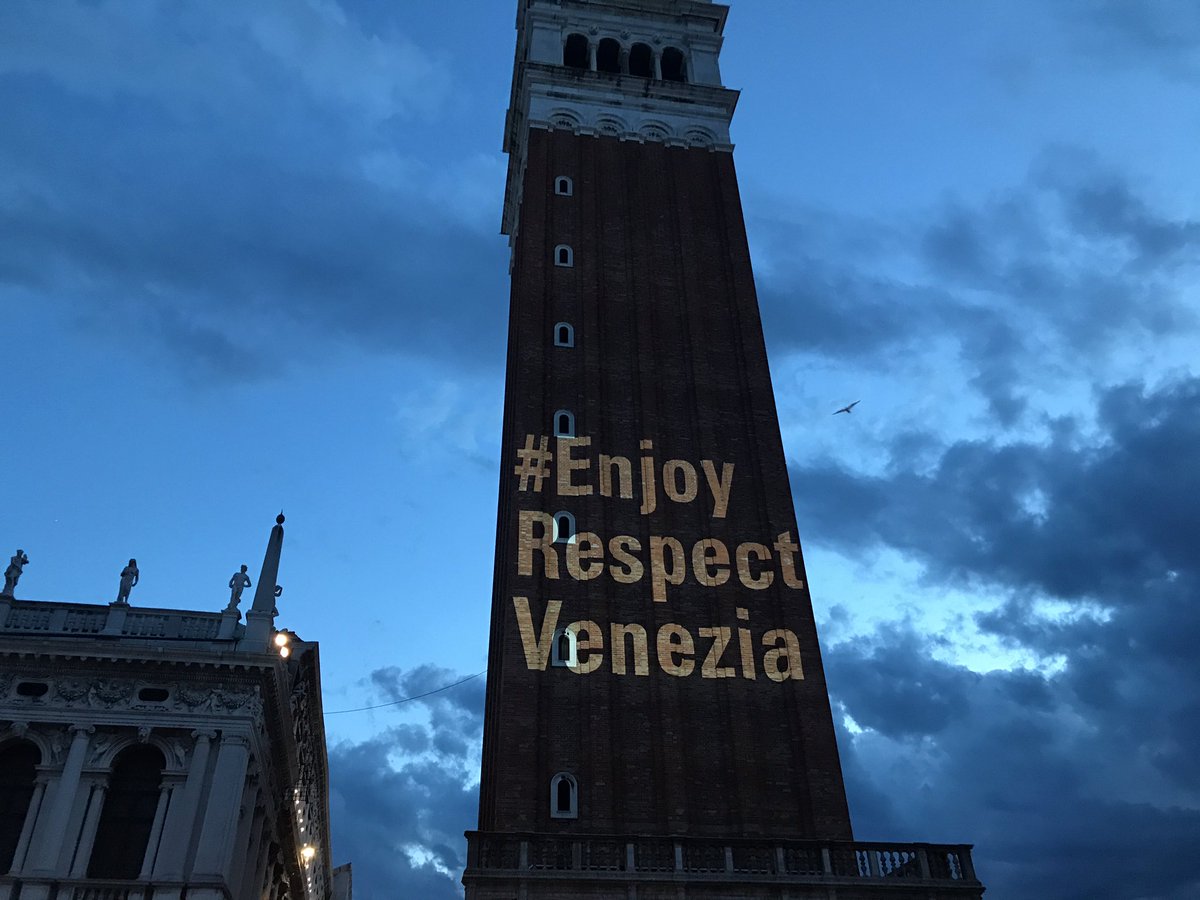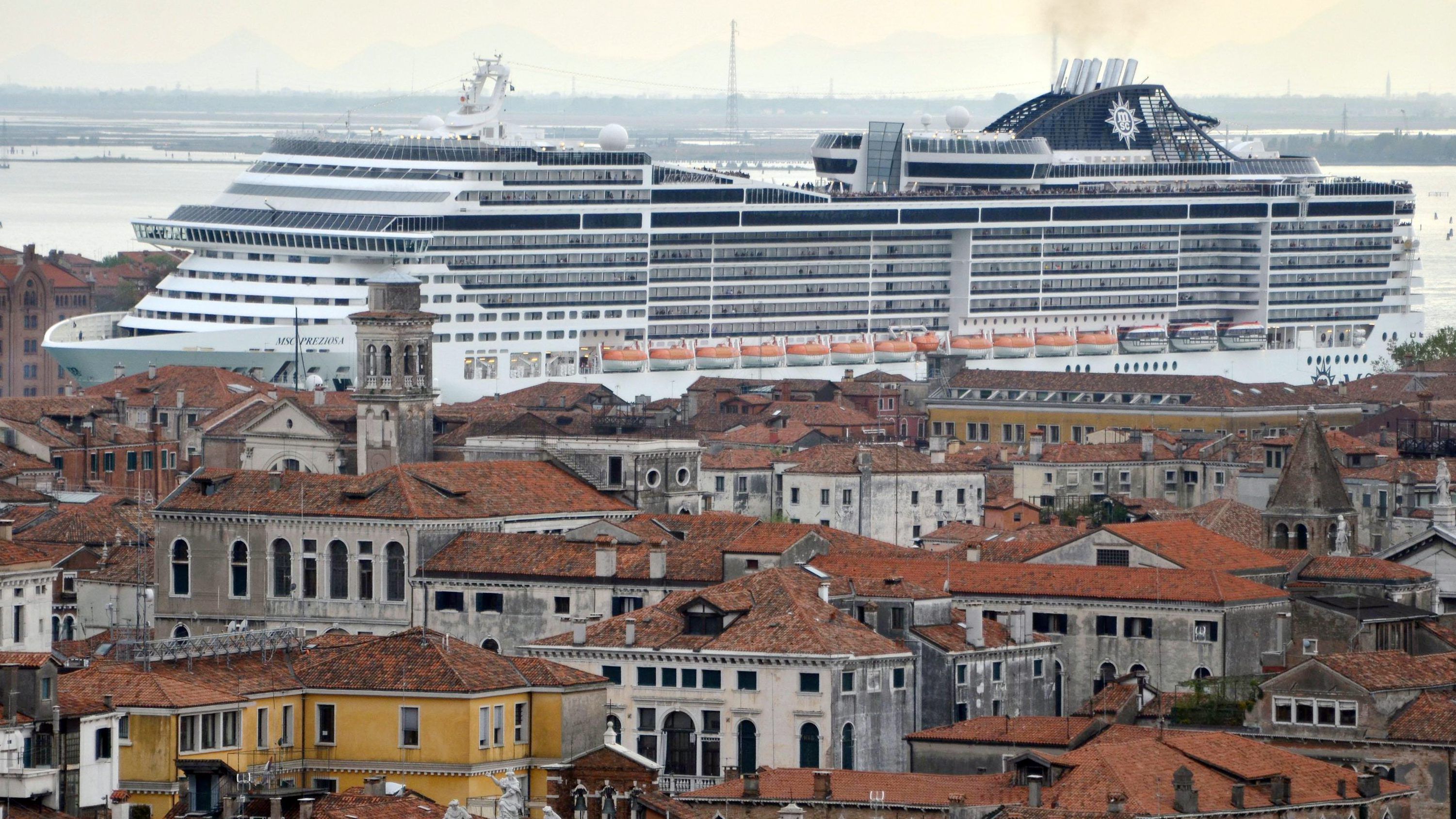Venice is being destroyed by tourists, and I’m a tourist.
Of course, like many who don’t want to be thought of by the locals as ‘the English woman who stumbles over her (very) limited Italian when ordering food’, the word “tourist” can seem often feel like a dirty word, especially when you’re due to embark on your 5th visit in two years (8 overall) and ditched any kind of map by the first visit.
Steeped in since rising from the lagoon in 400AD, Venice’s maze of canals, beautiful architecture, contribution to art and trading is beginning to disappear to under the weight of an “eat and flee” brand of tourism, so much so that during Redentore, St Marks Campanile was lit up with the socially savvy campaign..
#EnjoyRespectVenezia.
The campaign, launched by the city’s tourism chief Paola Mar just in time for the overwhelming crowded summer season is aimed towards not altering the natural and artistic environment, and not obstructing the development of other social and economic activities in harmony with the daily life of residents.
With 20 million tourists descending on Venice each year, it’s not surprising that residents feel inundated by visitors, especially considering the population of the city is down to 50,000 Venetians, with numbers dropping dramatically from around 175,000 in 1951. The reason for the decrease? Tourism.

Photo Credit: @paolopuosi
I see their frustrations of the local residents and am all too understanding and have witnessed first hand how tourism within Venice is destroying the city. I too, like the residents hate the sight of the giant cruise ships passing through the Giudecca Canal like stark white monstrosities against elegant landmarks and the crowds of tourists huddled beneath a walking flag, plugged into an audio guidebook whilst blocking bridges or narrow calle.
Upto 6 of the mammoth cruise ships can dock in Venice on any given day, with thousands upon thousands of excited visitors spilling into the streets of the city with guide book in hand, a time to be back at the ship and only a few euros in their pocket for the necessities. They indulge in the odd gelato, grab a slice of overpriced pizza and purchase cheap knock off “Murano” glass that is often imported from China and not the nearby island before returning to the ship after 8 hours of pounding the payments. This is the type of low quality tourism the city wants to be rid of.
“The beauty of Italian towns is not only the architecture, but it’s also the actual activity of the place, the stores, the workshops.”
It’s the souvenir stores, faux Burano lace, cut price Venetian masks and cheap looking tea towels or aprons depicting landmarks in gaudy colours for tourists to take home that are beginning to give Venice more of a seaside town feel. A beautiful and historical city, brimming with culture that one-night-stand tourists leave untapped during their visit and never return because they claim to have “seen” Venice. They’ve seen the heaving Piazza of San Marco and crowded Rialto Bridge without ever stepping foot in a family restaurants that has been passed on through generations or the background of the impossible Serenissima, founded on wooden piles in the lagoons of the Adriatic. They’ve ridden in a Gondola, taken a selfie off of the Accademia Bridge and retreated to their cruise ship or mainland accommodation without enriching a city they themselves have been enriched by.
You only have to look at Venice in the evening compared to the day to see how the two compare once the majority of tourists are tucked up in bed. Whereas you’ll find yourself wanting to escape the oh so beautiful but busy Piazza San Marco in the day for the quieter streets of Dorsodoro or Cannaregio, the evenings bring a sense of serenity to the city and the sound of footsteps on the busy Calle will be those of locals or those who favour Venice in its quieter hours. Interjected of course by the sound of suitcase wheels and the rustle of maps from newcomers to the city attempting to navigate the cities intertwining streets.

But cruise ships bring in tourists and tourists bring in money, and Venice not being the trading colossal of its hey day does depend on the income from tourism. The dwindling numbers of gondoliers within the city depend on their 40 minute , waiters in restaurants, hotels. But how much of that individuality should a city have to lose to tourism for the sake of a euro before it loses it’s identity completely and all that is left is a museum?
It’s much the same any city, be it Venice, London or your hometown. Identity is found within the history of a city, it’s people and it’s trade. If residents don’t contribute or support local traders and independent businesses, slowly the town loses its individuality and economically the town becomes depressed. When you’re one of the largest tourist spots in Europe lack of contribution and investment from those 20 million visitors to the city not only leaves what was once a rich city gasping for economy, it leaves a bitter taste in the mouths of the locals.
Venetian’s don’t hate tourists (okay, some probably do) but with a younger generation coming of age in the city and wanting to enjoy their Venice, now (!) it’s easy to see where the frustrations come from. Not only is it harder and harder to stumble upon an independently owned boutique, it’s also increasingly difficult for Venetians both young and old to reside within the city they grew up in. With landlords in Venice realising that they can make more money renting property to tourists (and charging less that hotels) rather than permanent tenants, landlords are using property listing websites such as Airbnb, rather than offering long-term lets to locals at reasonable rates. This drives the cost to live within the city too high meaning they must relocate to the mainland of Mestre or even further afield.
This isn’t an issue that occurs just in Venice. There are the samiliar discussions arout tourism and economy happening in Majorca, Barcelona and Croatia and we as tourists need to become more mindful and respectful when enjoying another country.
So does that mean that tourism within Venice needs to stop? Not at all. Venice is a city that needs to be seen and enjoyed, in fact there’s a whole hub of locally based Instagrammers including Lorenzo Cinotti, Marco Paris and Marco Valmarana who love nothing more than sharing the beauty and culture of their city on a daily basis to show the Venice away from the landmarks overcrowded with tourists. Of course, as previously mentioned, a lot of the city’s income and businesses rely on money generated by tourism and as visitors to the city we have a responsibility to invest in Venice… or whichever city we’re in in the world. Immerse ourselves in the culture, spend our euros eating authentic dishes from a restaurant that has been ran by the current owners father and grandfather before him, learn about and appreciate the city.
And of course, the little things that make the locals home feel less like home such as loitering or picnicing on bridges, dropping litter or attempting to swim in the busy (and dirty) canals.
0 Comments